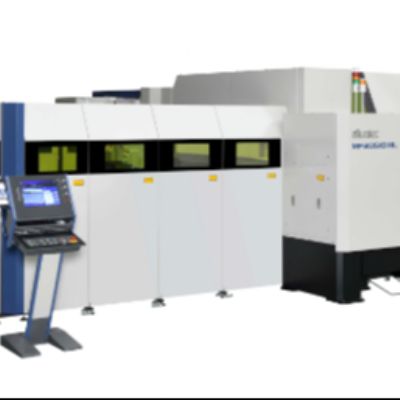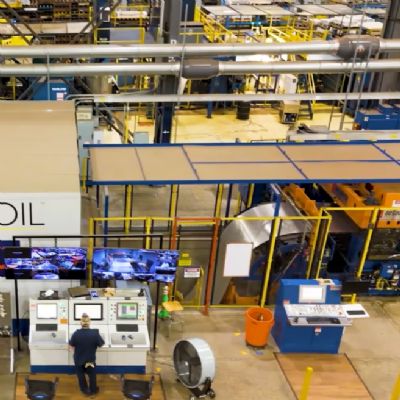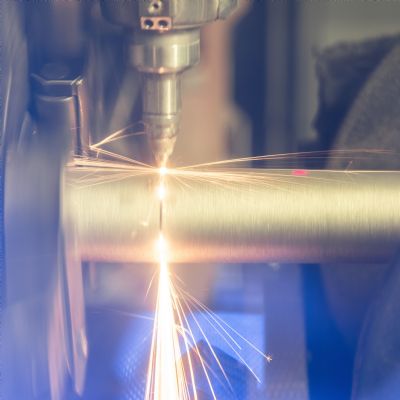Fate intervened in the form of the Atkins and South Beach diets, which, railing against carbohydrates, decimated the bagel industry in the early-2000s. That development coincided with the dumping of wire baskets into the U.S. market by overseas manufacturers, bringing a huge drop in orders and essentially relegating wire baskets to commodity products.
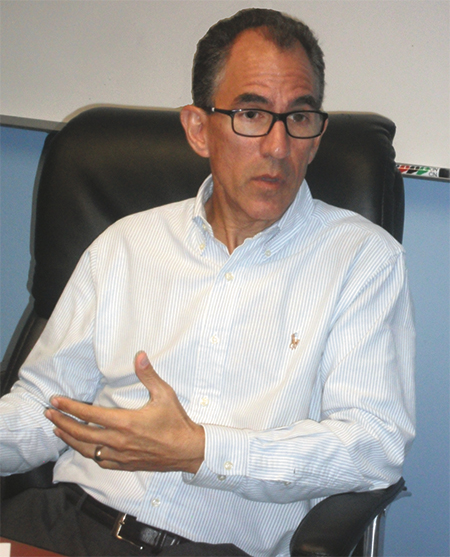 |
| “Incentives at Marlin are not just based on production and output,” says Marlin Steel chief financial officer Alex Levin. “We are incentivized to grow and learn by cross-training—by building skill sets—which ties into the company’s strategic objectives. Tactically, we compensate our employees and incentivize productivity and knowledge, which adds value to the company, and adds to employee health and welfare.” |
“We lost hundreds of thousands of dollars—it was a disaster,” says Greenblatt. “I was almost to the point of deciding to let the employees go and lose all my money. For 30 years, the company made bagel baskets and nothing else. I was about to lose everything.”
Literally in its dying throes, the company received a fortuitous phone call. An engineer from Boeing had seen a Marlin advertisement geared for bagel basket clients, and thought a similar container could find use in the aircraft maker’s production facilities. With a single huge order, the business embarked on a new mission, providing custom fabrications to industrial customers.
With renewed focus, Greenblatt decided to invest in new equipment to meet new demands, and, about a decade ago, relocated Marlin Steel Wire to Baltimore.
Today, the company, from its single U.S. location, supplies custom wire and mesh baskets, stainless-steel products, and other wire and sheet metal fabrications to all manner of markets, from automotive to home appliance. Customers have a choice of finishes including chrome, nickel, plastic, epoxy, zinc, brass, Teflon, Nylon, Halar and more. The company’s stainless-steel units can be electropolished for a shiny finish or delivered with a natural finish. Marlin’s industrial-grade wire and wire-mesh baskets, according to Greenblatt, are ideal for material handling, ultrasonic cleaning, sorting, degreasing and part storage. Clients worldwide include precision automotive suppliers, high-end medical and pharmaceutical laboratories, and industrial factories. Marlin also services suppliers to the U.S. military.
“It is fulfilling, from company and employee standpoints, that we make things in Baltimore and ship them all over the world,” Greenblatt says, noting that the company exports 25 percent of its products. “We can do that and still provide our people with good pay and benefits. We provide medical and dental insurance, contribute to 401k retirement, offer vacation and pay 100 percent for employee education. We have a great team and have built an ecosystem that works.”
|
From Temp. to Production Manager
Six years ago, Andy Croniser began his Marlin career as a temporary worker in a welding cell. Through his six-month temp. assignment and for two more months as a full-time employee, he learned all facets of the cell, graduating to the role of cell supervisor. Over time, Croniser took on additional duties, taking advantage of training to ultimately earn the title of production manager two-and-a-half years ago. In this position, he is responsible for all facets of Marlin production, including scheduling—people as well as product to make sure all production cells are fully stocked to meet manufacturing needs. He also establishes and tracks production goals. Another facet of his work involves working closely with designers, making sure that every print matches up with the production cost, equipment capability and customer price. Croniser even teams with the sales staff to develop quotes.
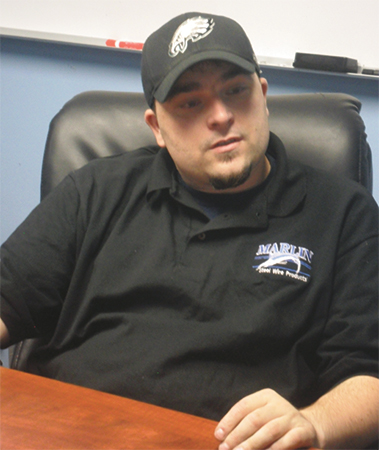 Recruitment, hiring and retention also fall under Croniser’s umbrella. Marlin recently brought on a consultant to help develop an assessment test, which Croniser is set to employ in order to gauge potential hires. Recruitment, hiring and retention also fall under Croniser’s umbrella. Marlin recently brought on a consultant to help develop an assessment test, which Croniser is set to employ in order to gauge potential hires.
“I also help train production staff,” he says, noting that he himself takes full advantage of Marlin’s training program. “If it is my job to make sure a machine is running, I want to know how to run it. The more you know the more you can make, which was the biggest incentive for me. It brings job security, too. I don’t want to be disposable, especially in this economy.
“At industry association roundtables,” he continues, “while many manufacturers were gloomy in their assessments for the past couple of years, we were able to discuss our growth. We haven’t had to cut an hour from anyone here, that I recall, and wages and benefits at Marlin are top of the line. From top to bottom we have dedicated people and a good atmosphere. We have a good core group of employees and we try to add to that by bringing in people who are willing to learn. We are close, and push each other in a good . That is why we are successful, and it is my job to help promote that.”
The three-person Marlin safety committee, which Croniser heads, meets once a month and conducts company-wide safety inspections. The 1457 consecutive days without a lost-time incident as of this writing is testament to the committee’s efforts and the safety focus at Marlin. The company twice has brought in MOSH, Maryland’s OSHA arm, to conduct safety assessments.
“They found 16 items that needed improvement on the last check, and we improved every one,” Croniser says. “Drew directs us to do whatever it takes to address safety items, so safety awareness comes from the top at Marlin. We also stress housekeeping. We have a very clean shop, and we addressed that initially three or four years ago by changing the culture. We made shadow boards to make sure tools and equipment were stored safely for quick access, and developed a cleanup board that gives employees a checklist of housekeeping items to address at the end of each day.” |
Total compensation for Marlin employees ranks in the upper quartile of similar business in the region, according to company benchmarking, or $10-$30/hr, according to company officials.
‘Quality, engineered quick,’ the company’s Secret Sauce, according to Greenblatt, is the mantra that transformed Marlin. With nearly 30 percent of employees functioning as engineers and part designers, the company boasts expertise in providing customized products—from print to part to customer—in rapid fashion.
“When a Japanese automotive company wants us to export $100,000 of laser-cut parts, that happens because of our value-added engineering,” Greenblatt says. “It is worth it for a company located half around the world to buy from an East Coast manufacturer because we have moved the efficiency and productivity needle, which is driving our record growth over the past four years.”
In fact, Marlin has been named to the 2012 Inner City 100, a list compiled by the Initiative for a Competitive Inner City, to identify 100 high-growth private companies located in inner cities across the United States. Marlin earned the lofty status due to its five-year compound annual growth rate of 11 percent on revenues of almost $4.5 million in 2011 and exceeding $5 million in 2012.
As Marlin grows, it has increased its space to 28,000 sq. ft., recently upping the number of dock doors by 80 percent to allow simultaneous loading and unloading of more trucks, creating a U-flow style of manufacturing to provide a logical route of raw material to production and then to shipping. Other improvements include doubling the number of skylights to allow robot operators to inspect work in natural light, painting walls a reflective white to better eyeball product quality; sealing and painting the floors so ease cleaning; and doubling engineering office space. The company also has increased warehouse space.
“We are huge about keeping work in this country,” says Alex Levin, Marlin chief financial officer. “The United States cannot lose its industrial base. So we value ingenuity. Race to the bottom on price and you will lose every time.”
Earning extra pay via the combination of undergoing skills training and meeting production goals is an ideal arrangement, and a major reason why Levin recently joined Marlin.
“Incentives at Marlin are not just based on production and output,” he says. “We are incentivized to grow and learn by cross-training—by building skill sets—which ties into the company’s strategic objectives. Tactically, we compensate our employees and incentivize productivity and knowledge, which adds value to the company, and adds to employee health and welfare. If a new employee can run a punch press, and within a year or two can run a punch press, laser cutter and a robot —with each incremental skill set gain comes an incremental increase in base compensation. Beyond that, producing at a high-quality consistent level brings the ability to make significant dollars above base pay.”
Bonus and skill set programs positively affect recruiting, according to company officials. Marlin partakes in a temp.-to-hire program, where temporary workers can work their into full-time employment over time, typically three months. Though not eligible for bonus programs, temporary workers see the publicly posted charts, according to Greenblatt, giving them incentive to follow a path to full employment. In turn, he says, temporary and full-time employees communicate benefits of the bonus programs to friends who may develop interest in pursuing a Marlin career path.
Skills Matrix Drives Cross-Training
|
Training Program Brings Advancement
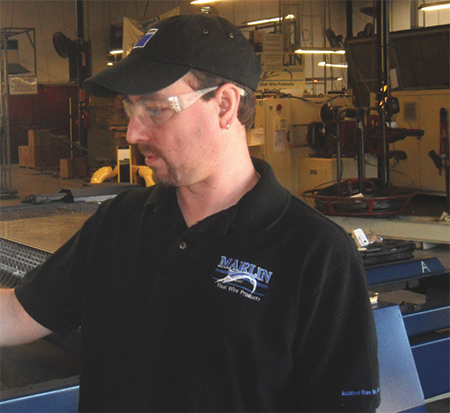 Beginning his Marlin career six years ago as a tooling-fixture maker, Kendall Browning, now as a manufacturing technician, oversees two other employees. Describing himself as pretty well-rounded upon joining Marlin, Browning took advantage of the company’s training program to learn almost every piece of large equipment, including a laser cutter, punching machine and press brake, as well as robots. Beginning his Marlin career six years ago as a tooling-fixture maker, Kendall Browning, now as a manufacturing technician, oversees two other employees. Describing himself as pretty well-rounded upon joining Marlin, Browning took advantage of the company’s training program to learn almost every piece of large equipment, including a laser cutter, punching machine and press brake, as well as robots.
“Over time, the company grew and I learned how to operate our new machines,” he says. “I have been able to advance here due to the training, and we have reachable production incentives because we all help each other. The production chart is updated daily with our progress so we know where everyone stands. We don’t let people flounder. I help out because in a couple of weeks I may need their help.”
Like Croniser, Browning appreciates Marlin’s family atmosphere.
“Visitors and new people comment about our teamwork,” he says. “Not just teamwork among a small group or cell, but throughout the whole company. That family atmosphere exists between the shop floor and front office, too. We have a lot of back and forth with our engineers. Maybe a designer wants to make a basket differently, or maybe a design doesn’t match how we like to build something on the floor, so we work together to iron that out. I interact with our designers and engineers on a daily basis.”
Browning also is a member of the safety committee, and is proud of Marlin’s safety record.
“If people on the floor notice a safety issue, they will communicate that concern and the committee will address that,” he says. “Or we can fix safety issues right a if needed.”
Would Browning recommend Marlin as a good place to work?
“If you want to be heard and to contribute, and don’t want to work in an abrasive atmosphere, Marlin is a great place to work,” he explains. “The company takes care of us and provides a lot of opportunities.”
|
The company lunchroom is home to the Skills Matrix, a publicly posted snapshot of who can do what at Marlin. The chart proves the company’s training commitment, as cross-trained employees bring all-important flexibility to the job shop and skills improvement puts extra money in employees’ pockets. Marlin budgets 5 percent of employee labor costs for training, well above the industry average of 1.1 percent, according to the Precision Metalforming Association’s benchmarking survey.
“The Skills Matrix is a wonderful tool to encourage cross-training,” explains Greenblatt. “With the Skills Matrix program, we show, in a transparent (via the posted chart), what skills we care about. The message to our staff: We care about these skills. Please learn them. If you learn them you will earn a pay increase. As a result, we have increased efficiency in a massive over the years, and our employees are motivated and engaged.”
The Skills Matrix lists all possible job requirements, displayed horizontally on a spreadsheet, with every employee listed vertically along the top. The chart tracks what each employee can do and to what level of proficiency. Employees can sign up for available training on a posted sheet. The matrix divides skills into direct- and indirect-labor classifications. Examples of direct-labor skills include bending, side-frame welding, Amada press-brake setup, Trumpf (operating) and Trumpf (programming). Indirect labor skills include quality inspection, fixture design and first responder, among others.
Training typically occurs inhouse after a shift, so trainees are paid overtime, as are the inhouse instructors. The company also sends affected employees for outside training on new machinery and processes. Once employees receive training and demonstrate proficiency in new skills, they receive an hourly wage bump of 50 cents to $1, depending on the skill, according to Greenblatt.
“That can be a $2000/yr. raise for learning a new skill,” he says. “That wage increase is permanent, and paid whether they work in that new skill or not. Not only have they enhanced their lifestyle and their families’ lifestyles by being proactive in learning new skills, but they become indispensible to the company.”
Properly trained employees not only squeeze more out of equipment, but their skills help reduce scrap and improve productivity and part quality.
“Because of our emphasis on cross-training, we have improved efficiency,” says Greenblatt. “Our people are agile and can jump from machine to machine, so we are impervious to issues such as two laser operators being out at the same time. As a job shop, we may be slow in one work zone and heavy in another on certain days, so we repopulate cells as needed. Transferable skills enable that.”
A panicked call from a major retailer provides a recent example of cross-training benefits for Marlin and its customers. The retailer had ordered 7000 wire baskets from a Chinese manufacturer, but the supplier couldn’t ship in time.
“We received a call for the work on a Wednesday, on Thursday we received a purchase order and on Friday the customer approved a print drawn up by our engineers,” recalls Greenblatt. “Within a week we shipped 4500 baskets and shipped the rest a week later.
“We had never made this type of basket,” he continues, “but we can offer speed to our customers because of our engineering skills and cross-training. We produced prints quickly and moved people to cells to produce that work in a hurry. I don’t know what customers will order next week. That is part of the benefit of us being so broad—everything from milling to laser to punch to wire—combined with our cross-trained employees. If one workcell goes heavy, we can fill it with people who know how to do the work. That makes our people valuable and impervious to recession.”
In fact, during the brutal manufacturing landscape in 2009, Marlin did not lay off a single employee, for which Greenblatt is rightly proud. The Skills Matrix and related training program is largely responsible for that, and also provides the benefit of showing, at a glance, which skill areas are deficient and require more trained employees. Marlin so focuses on cross-training that the company will overdo it, admits Greenblatt, sending more employees than sometimes necessary.
“We have less than 35 employees and we have sent eight of them for punch-press training,” he says. “But the punch presses are very important to what we do so we want to make sure we’re als covered. Pretty much any employee that wants to learn a skill will get a shot at it, maybe not in the first pass, but definitely at some point. Convincing people to avoid complacency—where they are comfortable with their current skill sets—is the biggest challenge we face in our training program. Incentives such as the automatic wage increase combat that.”
With engineering so key to company success, Marlin invests in its design capabilities. The company hires many of its engineers from the University of Maryland’s highly regarded School of Engineering, located only about 30 miles a. At Marlin, engineers use state-of-the-art design software, according to Greenblatt, and undergo software, programming and machine-operation training under the Skills Matrix program. The company also provides engineers and other front-office employees with 30-in. computer monitors for design work, and another 28-in. monitor to access e-mail and other programs. The setup reduces eye strain and eliminates the need to constantly switch on-screen windows to access multiple programs.
Training Pays Off in Production
Incentives at Marlin do not end with training. New skills can bring production bonuses, paid on a regular basis, often in a following paycheck. Bonuses, a dollar amount based on a percentage of a particular job or task, are arranged around workcells and/or teams, including front-office support personnel such as designers and purchasers.
|
Flexibility, Job Security Give Confidence in the Company
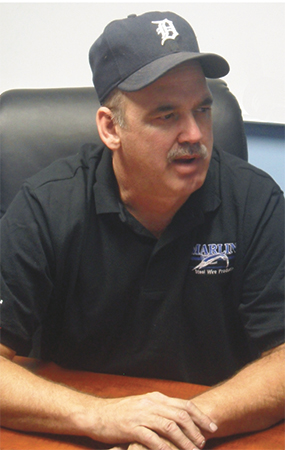 Nathan Myers, senior robotics setup technician, has worked at Marlin for 12 years, often performing other jobs outside of the robotics realm thanks to cross-training. Nathan Myers, senior robotics setup technician, has worked at Marlin for 12 years, often performing other jobs outside of the robotics realm thanks to cross-training.
“I may be responsible for six machines on a daily basis, including setup, monitoring and quality, so I am just circling,” he says. “That makes the day go quicker. That is the nice thing about this job: It is not tedious.
As a section leader, Myers oversees two other employees, often assisting in cross-training the two to expand their skills.
“I try to be hands-off with training techniques,” he explains. “I think you learn more by doing it yourself, with guidance.”
Myers, who received a significant raise upon joining Marlin and has benefitted financially from its cross-training and production-goal programs, is happy working at the company, and would recommend Marlin to others.
“At first, I was afraid that I would be chained to a machine with no flexibility,” he says. “But the more you learn here, the more independent you can be. It is up to individuals as to how much they want to learn and on how many machines they want to be trained. I have als had the opportunity for overtime, and can’t recall any layoffs during my years here. That gives me confidence in the company. I am glad to be at Marlin, and think that others would like it, too.” |
“Everyone has a stake in the bonus program, so all departments pull for success,” says Greenblatt, detailing the unique arrangement. “Engineers have to supply good part prints in a timely manner, for example, and purchasers must make sure we have the material on hand to complete a job. So we tie a lot of functions together in determining who is eligible for which production goal.”
When the bonus program began seven years ago, only the production manager had a stake. Over time, company officials realized that reaching a goal demanded effort from other employees and other departments, so the program evolved to include anyone and anything that drove project success.
Marlin’s bonus compensation plan certainly has put dollars in employee pockets, with production employees earning anywhere from 5 to 156 percent of their hourly or salary compensation in bonuses in 2012. Most employees are in the 10 to 40 percent range, and bonus payouts in 2012 ranged from $50 to more than $20,000. Bonuses are paid above and beyond steady hourly compensation increases earned via skills enhancement.
At Marlin, the production manager is responsible for setting all bonus-program goals, which usually run for a week or two. Greenblatt believes that the company has reached a good balance, with goals that are achievable, but requiring effort to attain. For example, he notes, in the past 26 pay periods prior to MetalForming’s visit, the company paid out bonuses in 14 periods. Employees are not penalized for not reaching goals, with shortfalls earning scrutiny as part of continuous-improvement efforts.
Production bonus goals are displayed publicly at Marlin, allowing all employees to chart progress.
“Doing that provides some competition, where our people can see how we measure up to other teams,” says Andy Croniser, Marlin’s production manager who personally sets production goals and charts progress.
As mentioned, bonuses are paid quickly, an important aspect of the program. Incentive can be lacking when employees are working in February to achieve a one-percent bonus payable in December, according to Greenblatt.
“We want to keep incentives right in front of employees, and we want them to be paid for success in a timely manner,” he says.
In some cases, reaching goals means working overtime. The company makes that easier for employees, given a four-day, 10-hr. work week spread across two shifts.
“If we work overtime, it is on a Friday, so even then we still have the weekends to ourselves, which is a nice benefit,” says Croniser.
Benefits like that foster teamwork, according to company officials, and bring a can-do attitude.
“Teamwork and the sense of working toward a common goal really comes through at Marlin,” says Levin. “People here consistently go above and beyond—developing good ideas, arriving early, staying late. It comes from the top. As president, Drew really tries to foster that culture. Our productivity goals drive much of that, too. Bonus programs in place at some manufacturing companies, with a set amount paid at some distant point in time, do not have immediacy. Instead, those setups tend to bring complacency where the bonus is just expected as part of compensation.”
A sandbox attitude can be a pitfall in production goals for small teams, as team members may focus solely on their own goal to the detriment of the organization. That’s not the case at Marlin, says Levin.
“I have seen that in other environments but not here,” he says. “People at Marlin are not overly protective of their sandboxes. Much of that has to do with the Marlin culture, which, again, is driven from the top. Drew is a great cheerleader for the company, continuously pointing out our successes in a public forum, and making people feel good about what they are doing and the contribution they are making to the organization. Even though we are incentivized within teams, I don’t think anyone here wants to let nonteam members down.”
Marlin’s production-goal program essentially fills the shop with a roster filled with entrepreneurs, according to Greenblatt.
“The program engages our employees, giving all of us ‘skin in the game,’” he says. “Their motivations are in complete alignment with mine. They understand the company mission and are rewarded promptly for success. We developed a micro-system, mostly cell-driven, and some cells may contain only one person. That single person can control his own destiny, take action and innovate to be as productive as possible.”
Employees are Fixed Assets at Marlin
“Many companies look at employees as variable expenses,” says Greenblatt. “We look at our employees as fixed assets, and there is a massive philosophical difference. The people at Marlin know that if the company has a bad week or month regarding new orders, the people are protected—without worrying about layoffs. (During the last recession, the company’s flexibility not only allowed it to retain all employees, but actually increase sales, according to Greenblatt.) They can make steady rent and mortgage payments, provide for their families and enjoy an improved lifestyle. We spend a lot of money to train our people, making them valuable to keep and allowing the company to succeed.
“With a multitude of skills, and compensation for learning new skills and meeting goals, employees are more likely to have longer tenure at Marlin,” Greenblatt adds. “As a result, the Marlin team is passionate about the company, and customers notice that we will go above and beyond to meet their needs.” MF Industry-Related Terms: Core,
Fixture,
Form,
Gauge,
LASER,
Case,
Abrasive,
Bending,
Brass,
Mesh,
Scrap,
Punch Press,
Run,
Ties,
UltrasonicView Glossary of Metalforming Terms Technologies: Cutting, Training
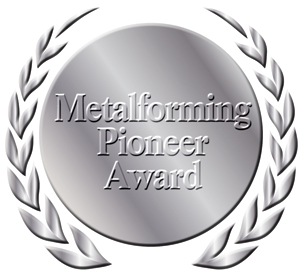 The bagel business wasn’t cutting it. That simple realization more than a decade ago unleashed a chain of events that has culminated in Marlin Steel Wire Products LLC, Baltimore, MD, earning a Hitachi Foundation Pioneer Award. The award recognizes Marlin’s efforts in workforce development, allowing its 32 employees, two-thirds of them involved in production, to learn new skills and boost productivity. The company exhibits innovation in developing and fostering skills and productivity programs that put money directly into employee pockets.
The bagel business wasn’t cutting it. That simple realization more than a decade ago unleashed a chain of events that has culminated in Marlin Steel Wire Products LLC, Baltimore, MD, earning a Hitachi Foundation Pioneer Award. The award recognizes Marlin’s efforts in workforce development, allowing its 32 employees, two-thirds of them involved in production, to learn new skills and boost productivity. The company exhibits innovation in developing and fostering skills and productivity programs that put money directly into employee pockets. 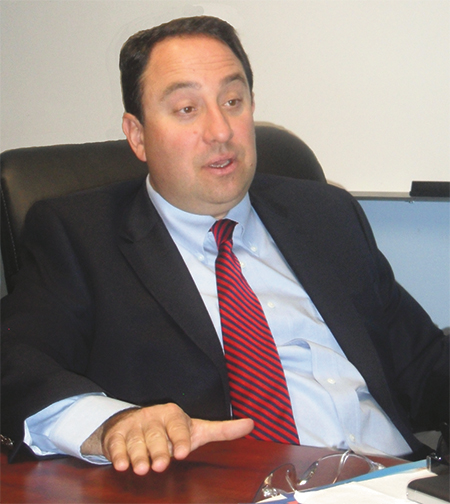








 Recruitment, hiring and retention also fall under Croniser’s umbrella. Marlin recently brought on a consultant to help develop an assessment test, which Croniser is set to employ in order to gauge potential hires.
Recruitment, hiring and retention also fall under Croniser’s umbrella. Marlin recently brought on a consultant to help develop an assessment test, which Croniser is set to employ in order to gauge potential hires.

